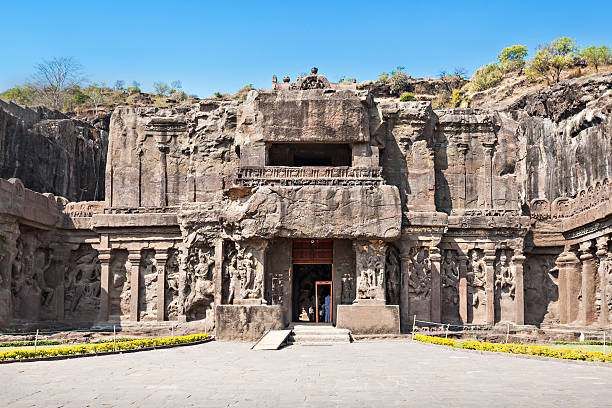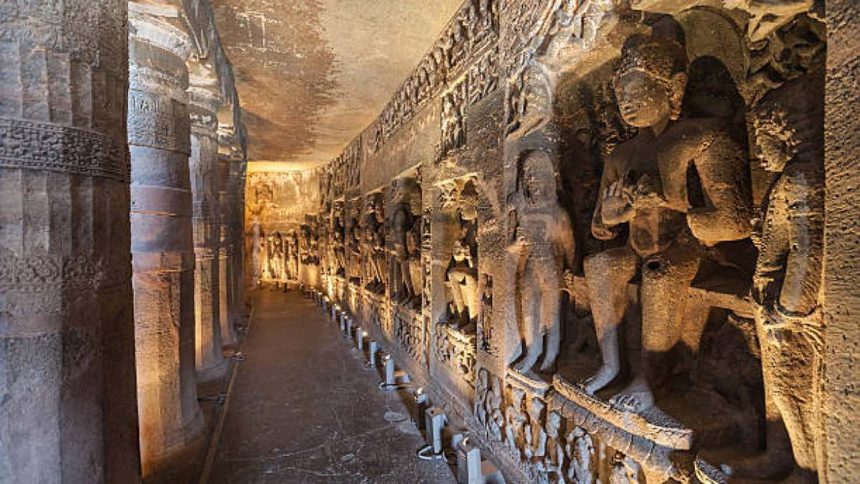The Ajanta and Ellora Caves are renowned for their exquisite rock-cut temples, attracting history enthusiasts and travelers from around the world. These ancient caves are not just architectural wonders but also hold immense cultural and religious significance. Located in the state of Maharashtra, they are a testament to India’s rich heritage, offering a glimpse into the artistry of the past.
Ajanta Caves: A Glimpse Into Buddhist Heritage
The Ajanta Caves, located near the village of Ajanta, are approximately 102 kilometers north of Aurangabad. This UNESCO World Heritage Site is easily accessible, with the nearest railway station being Jalgaon. For those traveling from Aurangabad, the distance is also manageable. Visitors can find various accommodation options near the caves, making it a convenient destination.
Ajanta consists of around 30 caves, all of which were carved during the rock-cut period of the Buddha, dating back to between the 1st century BC and the 7th century AD. These caves are carved out of granite rocks, set within a 22-meter (70-foot) high hill overlooking the Waghurna River. The caves primarily serve two purposes: chaityas (prayer halls) and viharas (monastic halls).
The larger caves are adorned with massive pillars that extend to the ceiling, while the walls are beautifully painted with scenes from the life of Gautama Buddha. Notable caves, such as Cave No. 1, 2, 16, 17, and 19, house stunning paintings, while Cave No. 1, 4, 17, 19, 24, and 26 showcase exquisite stone-carved sculptures.
Ellora Caves: A Fusion of Religions
Ellora, another UNESCO World Heritage Site, lies around 29 kilometers northeast of Aurangabad. The caves here are spread across a 2-kilometer stretch and are divided into three sections, each representing a different religion: Buddhism, Hinduism, and Jainism. The historical significance of these caves spans from the 4th to the 9th centuries, showcasing the evolution of rock-cut architecture over time.

Ellora boasts a total of 34 caves, comprising temples and viharas. Among these, the Kailashnath Temple stands out as a masterpiece of Indian rock-cut architecture. This awe-inspiring temple, measuring 50 meters in length and 29 meters in height, is carved from a single rock. The intricate stone carvings depict various gods and goddesses, offering a glimpse into the spiritual and artistic achievements of the time.
The Shiva Temple within the Kailashnath complex is particularly noteworthy. Constructed during the Rashtrakuta dynasty in the 8th century, it features an open pavilion adorned with colossal elephant statues and a sacred bull, symbolizing Lord Shiva’s vehicle, Nandi.
How to Plan Your Visit to Ajanta and Ellora Caves
Every year, thousands of visitors are captivated by the beauty and historical significance of the Ajanta and Ellora Caves. To make the most of your visit, it’s essential to plan your trip in advance. Consider staying in nearby Aurangabad, which offers a range of accommodation and transportation options. The best time to visit is during the cooler months, from November to March, when the weather is pleasant for exploring the caves.
Whether you’re a history enthusiast, a spiritual seeker, or simply a traveler in search of breathtaking sights, the Ajanta and Ellora Caves promise an unforgettable experience. These ancient wonders continue to inspire awe and admiration, standing as a testament to India’s enduring cultural legacy.




